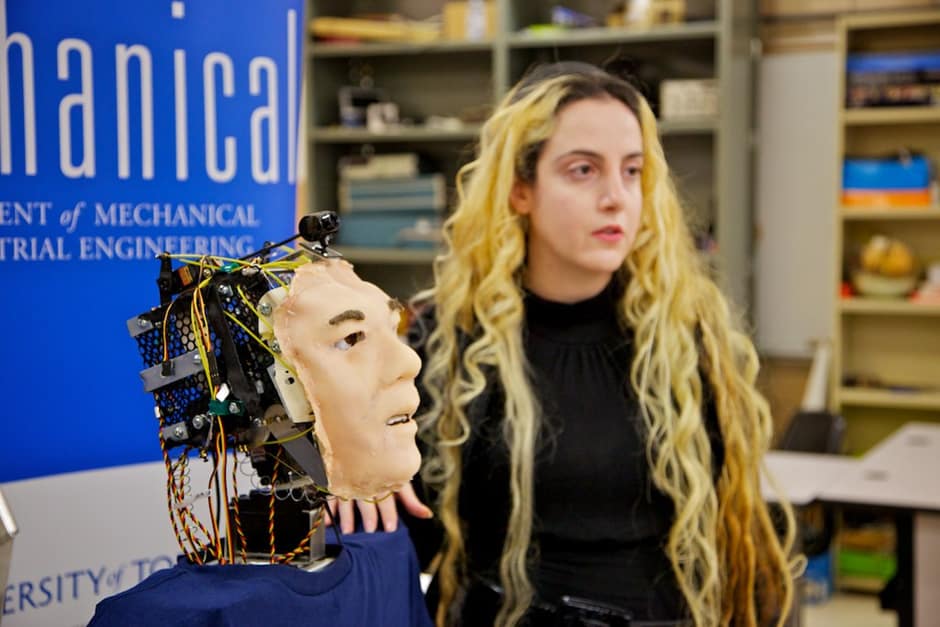Robots seem less and less fitting on their mantle in science fiction movies, and more suitable in documentary films, as they fill important roles in our everyday lives, in part thanks to the research of Dr. Goldie Nejat. Nejat was named Canada Research Chair (CRC) in Robots for Society at the University of Toronto last week. Nejat’s research has been featured in Time magazine, and won her Engineers Canada’s 2013 Young Engineer Achievement Award.
In an interview with The Varsity, Nejat discusses how she reached to the top in her field.
The Varsity: What inspired you to pursue science for a career?
Goldie Nejat: Looking at the developing systems that I could physically see. When I was growing up there was a lot of new technology coming out — cell phones, laptops and we were learning a lot about them [just] as they were coming out and so that was exciting to see. So it was kind of an exciting time to be involved designing technologies, thinking about quality of life and designing systems people can benefit from.
When I came to university, robotics obviously existed in some of the traditional areas such as in manufacturing, and it became popular outside some of the applications that we had seen them in- you’re seeing robots potentially in healthcare, and our homes. It’s exciting to see this new technology that’s been designed to be in people’s reach so that people can actually use it. It’s no longer just for specialized applications where only trained people [are able] to use it. This kind of technology wave was an inspiration.
TV: What experiences from your undergraduate career led you here?
GN: In fourth year I had a few different opportunities to really get some hands on experience in robotics. By taking courses that had design projects in robotics, and doing a thesis in robotics. It gave me a lot of different opportunities … Taking [in] all that expertise and theoretical knowledge, as well [as] having the opportunity [to do so] in a few different courses was exciting. I wanted to do more in robotics and [I had] the opportunity to do it … When you’re an undergrad looking to do a specialization, the most important thing is to try it out. That was the best thing that I had, and I had the privilege to work in this area, on projects related to robotics, and that motivated me even more keep going in this area.
TV: What was your reaction to your appointment to the CRC?
GN: Very excited! It’s great since … it brings exposure to this area of study, especially in Canada. Robotics is an emerging area with many different applications, and this is the perfect time for the government to invest in robots, and how they can be used to help improve people’s quality of life, whether it’s at work or [in the] home environment.
TV: Are there any projects you are extremely optimistic about?
GN: There are two major robotics projects that we’ve undertaken in the last decade. One is our search and rescue robotics project. The main idea of that is looking at how we can use robots in dangerous environments. For example, after a large earthquake with collapsed buildings and rubble, we consider use of robots to explore environments, locate, and map potential victims. That information would then be delivered to rescue workers, focusing their attention to those areas and getting the victims out. In that example, you can even use robots to test the structural stability of the buildings to make sure it is safe for rescuers to enter … Our other project focuses on dealing with the increasing demand on our health care system due to the changing demographics with an increasing elderly population, by seeing how we can use robots to assist and improve the quality of life … We see how robots can help people with the activities of daily living, that you and I may take for granted at this point in our lives: brushing our teeth, getting dressed, making a meal.
TV: Where do you envision research in your field in the next decade?
GN: I think this is kind of the tipping point where we see these robots leaving research labs and entering society and this market boom. There have been a few platforms where robots have been developed, and now we’re addressing a lot of these challenges of costs and information. Creative off the shelf components — anywhere from using [an Xbox] Kinect or [Nintendo] Wii-mote sensor, will bring down costs and promote development of the technology. I see a great transition of robots leaving from the research labs and entering into the use, and in the next few years we’ll really be focusing on the aspect of how robots can be integrated into our society.
TV: What advice can you give to young, aspiring researchers?
GN: Here at U of T, there is a lot of research going on, behind closed doors maybe. But a lot of it is obvious to us when walking down a corridor. You can see there are a lot research labs, you can find out the names of key players, go on their websites, and learn more about the research that interests you. The most important advice is going on to take advantage and immerse yourself in that whole different hands on aspect while you’re here. U of T is one of the best research institutions in the world, and so whatever you may want to explore as your specialization or interest, exists here, and is an email or a knock on the door away. I would say, take advantage…of going to a lab, talking to a researcher in that area about it, and getting that hands on experience.
This interview has been edited and condensed for clarity and length


